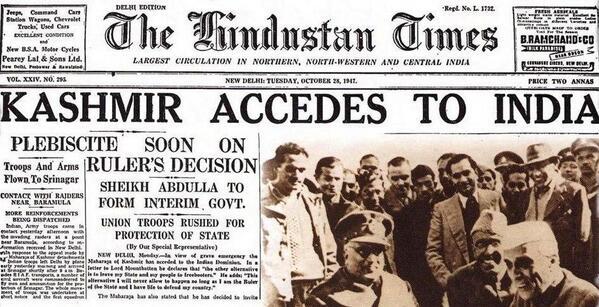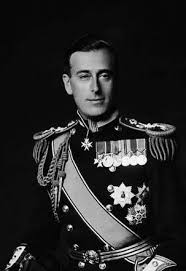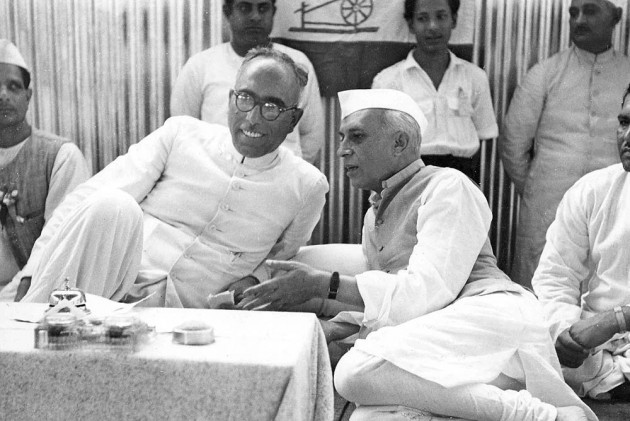On a cold October evening in 1947, the annual Dussera procession had begun at the Palace in Srinagar. Festooned elephants. Red Carpets. Music. Food. Royals in resplendent silks. They had gathered from all over the kingdom to pay their obeisance to their king – Maharaja Hari Singh.
As the party was on in full swing, the lights suddenly went out. An eerie darkness descended on the royal gathering. The Maharaja was filled with a sense of foreboding.
At Mahura, on the outskirts of Srinagar, a huge triumphant cry rose to the skies. The tribal lashkars had crossed over from Pakistan and taken the Mahura Bijlighar (Powerstation) that supplied electricity to Srinagar. (Read Part IV to know more about the tribal invaders).
A large part of Kashmir had been taken…and quite easily so. The Pakistani tribals were only a day’s march from Srinagar!
SOS
The Maharajah who had been dilly-dallying on his decision for so long and dreamed of independence (Read Part I for the start of the story), finally woke up with that jolt. He sent out SOS messages to New Delhi, pleading for help.
Pakistani raiders he said, had taken several parts of Kashmir. And his State Army was unable to cope. He needed help. And he needed it fast.
In Delhi an Emergency meeting was set up. The Cabinet deliberated and discussed the issue.
Kashmir was not yet a part of India. How could the Indian Army be sent in?
A decision was taken. India would help Kashmir provided Maharaja Hari Singh signed the Instrument of Accession, joining Jammu and Kashmir to India.
The message was taken to the Maharaja personally by V.P. Menon, Secretary to States Department and right hand man to Sardar Patel. Menon asked the Maharaja to leave Srinagar immediately for Jammu for his own safety.

The Maharajah was told India would come to his aid if he signed the Instrument of Accession, joining his state with India.
The Maharajah’s Army was being decimated. Muslim soldiers in his Army had defected to the Pakistani side. Poonch was under the control of the Azad Kashmir forces. Horrific reports of brutalities (murder, rape, arson, looting) of the raiders were coming in from Muzzafarabad, Baramulla Uri and other parts of the state. The Maharaja was desperate. He agreed.
In return, he asked for the insertion of a few special clauses into the Agreement, given the extra-ordinary circumstances and his hurried accession.
Menon returned to Delhi and went straight to the Defence Council Meeting that was discussing Kashmir.
“The Maharaja is ready to sign,” Menon told the relieved High Command. “Subject to certain conditions.” He set them out.
The matter was deliberated. There was intense pressure. The raiders were 24 hours from Srinagar. Any further delay and it could be all lost. The Committee agreed to the Maharaja’s special conditions. And on Lord Mountbatten’s suggestion, they also agreed to take the matter to the United Nations, once things returned to normal.
Menon flew to the Maharaja’s Palace in Jammu. The Maharaja signed the Instrument of Accession. “Save Kashmir!” he pleaded with Menon.
“If the Indian Army doesn’t arrived in Srinagar by tomorrow,” he told his aide, handing him a revolver, “Shoot me dead in my sleep!”
Menon assured the Maharaja India would not let him down. He flew back to Delhi. Sardar was waiting for him at the airport. Menon waved the Agreement in his hand.
Kashmir was in!

In less than a day, battalions of the Army were prepared, airplanes arranged, civil air traffic diverted for army use, weapons and ammunition arranged and the counter-offensive launched. The Indian Army managed to hold Srinagar and push the raiders back.
No End in Sight
The signing of the Instrument of Accession however, was not the end of the story. India naturally claimed that the Maharajah had signed the Instrument of Accession in its favour and hence that Jammu and Kashmir was legally a part of India.
Pakistan contested the accession on the grounds that it was signed by the Maharaja under duress /pressure. And hence that it was not valid.
This then blew out into an all-out confrontation with the Indian and Pakistani army clashing for Jammu and Kashmir. Within three months of becoming independent nations, they went to war.

As the war dragged on, the United Nations was brought in to mediate as per Lord Mountbatten’s suggestion, which had been accepted by the Indian leaders. The proceedings at the UN did not go to India’s liking. The Pakistanis were represented by a brilliant lawyer named Zafarullah Khan and the tide swung in their favour.
With UN intervention, a ceasefire was issued, and both the Indian and Pakistani guns fell silent. The ceasefire line is what we call the Line of Control.

The part of Kashmir which the Indian Army hadn’t taken back from the Pakistani forces then, remained under Pakistani control and remains to this day.
India calls that part POK or Pakistan-Occupied Kashmir. Pakistan calls the part under India’s control as IOK or India-Occupied Kashmir.
Both continue to claim the state as their own. There is a third voice too – that of a certain section of the people of Kashmir – demanding independence from both.
What is a Referendum and why did India agree?
A Referendum (also called a Plebiscite) is where the vote of the people is taken on an issue. In this case, India agreed to take the question to the people of Kashmir, once things returned to normal.
Over the years, Nehru has been blamed for this decision. People have demanded why this agreement was ever made? The answers are more complex than they appear.
Firstly, the promise made for a referendum by India was based upon the confidence of the ground situation in Kashmir. The Pathan raiders had just attacked Kashmir and the general public opinion in the valley was against Pakistan. The Indian Army had liberated the people from the raiders and the tide of popular opinion was overwhelmingly in India’s favour.
Further, Shaikh Abdullah, the popular leader of Kashmir at that time (Part II has more about him) was in favour of joining India.
Had a plebiscite taken place immediately, it is highly likely to have gone in India’s favour.
Telling factor is that Jinnah and the Pakistanis turned down the offer of a referendum then – precisely because they did not expect the people’s vote at that time to go in Pakistan’s favour.
Over the years, a lot has happened. Anti-India propaganda from the Pakistani side. Continued occupation by the Indian Army. Mass evacuation and exodus of Hindus from Jammu. Terrorism. Counter-terrorism.
As a result, the tide has changed. The promise of a referendum is now a thorn in the Kashmiri rose.
Further, the promise made was for a referendum once conditions returned to normal. But over 70 plus years, the conditions never returned to normal.
One looks back at those events of 1947-48 and wonders what could have been. Could things have been different had Maharajah Hari Singh taken a decision on time? Could things have been different if India had not taken the matter to the UN and pushed the Pakistani Raiders out completely instead?
We will never know.
Several interesting legal questions arise from the story that you can ponder about
- A document signed under pressure – Is it valid?
- If a promise has been made under certain circumstances and the circumstances change over time, is the promise still valid?
Over the years, China too occupied a part of Kashmir and unfortunately this was what the map of Jammu and Kashmir began to look like…

The story of course goes on and has not ended. Several other incidents happened thereafter.
Wars. Agreements. Terror. Propaganda. A lot of water has flown under the bridge.
The conflict drags on. And Kashmir continues to bleed.
Although the story is very long and complicated, I hope this Series of Five Parts (you will find links to them all posted together below) has given you a glimpse into the tip of the iceberg and the beginning of the long saga of Kashmir, encouraging you to read more about it.
Sign up to the Site so you can catch up on fascinating stories from Indian History and Culture!
566
The Dramatic Story of India’s Unification
My Book with Hachette Publishing House, will be narrating for the first time, the saga of Accession by Princely States, for Children. Including the Story of Kashmir.
Stay Connected to Stay Posted.

Sudhir Badami
December 21, 2019 - 2:49 pm ·Congratulations Mallika.
I will read this little later.
Going by my memory, the implemented political map of J&K and Ladakh is different from what was placed before Parliament.
mallikaravikumar
February 10, 2020 - 10:36 am ·Thank you…
This map on the blog cover is for representational purposes only. No political implications whatsoever.
PG
March 23, 2020 - 7:36 pm ·Very informative and lucid at the same time. It shouldn’t be labelled as “for kids”….its good for all and sundry 🙂
It indeed feel sad to see such tragic state of affairs and that too a a land which itself is a bliss.
It feels like a beautiful nymph has been cursed to bleed…every time you admire the beauty, you also see the undue blood oozing out 🙁
It also feels like law of nature…. all check-boxes can never be ticked !! Price of being beautiful
mallikaravikumar
March 25, 2020 - 11:42 am ·Thank you so much for reading and writing in. Yes…I am told that quite often…perhaps I should re-think the title of the blog as well 🙂